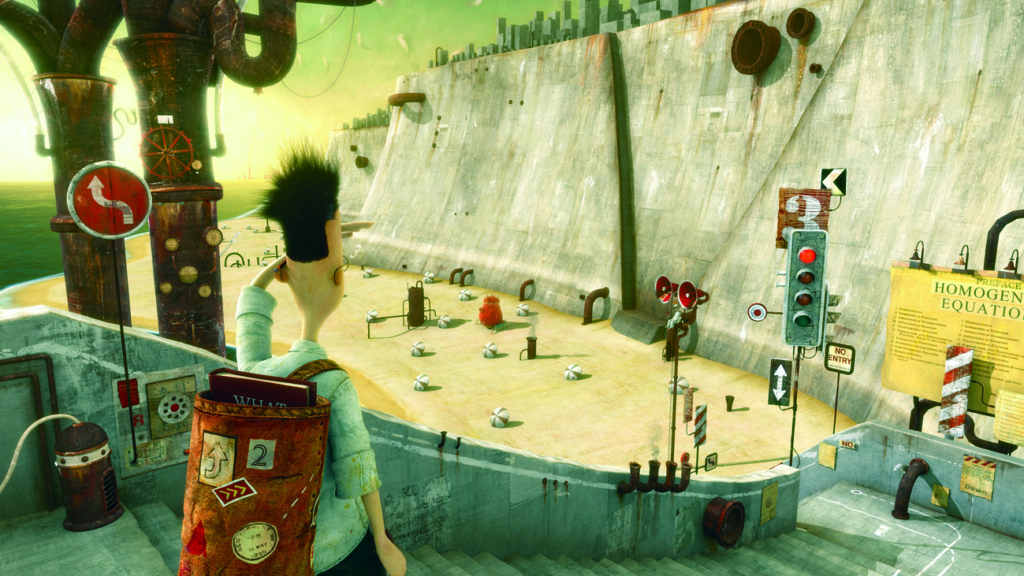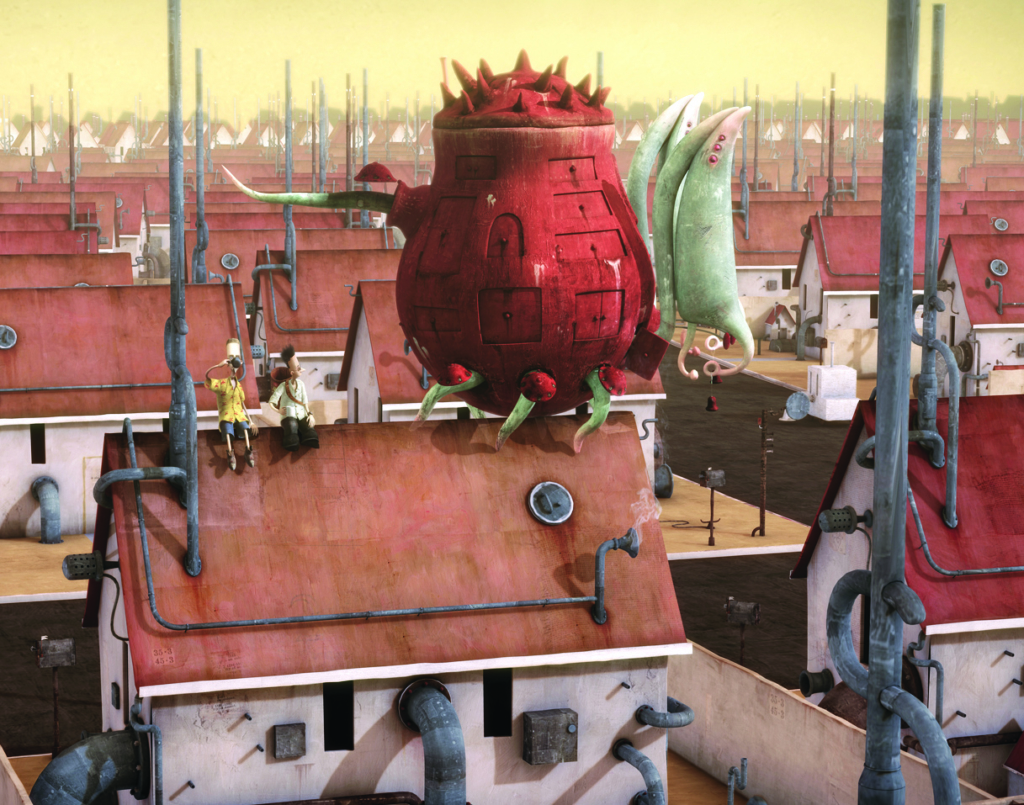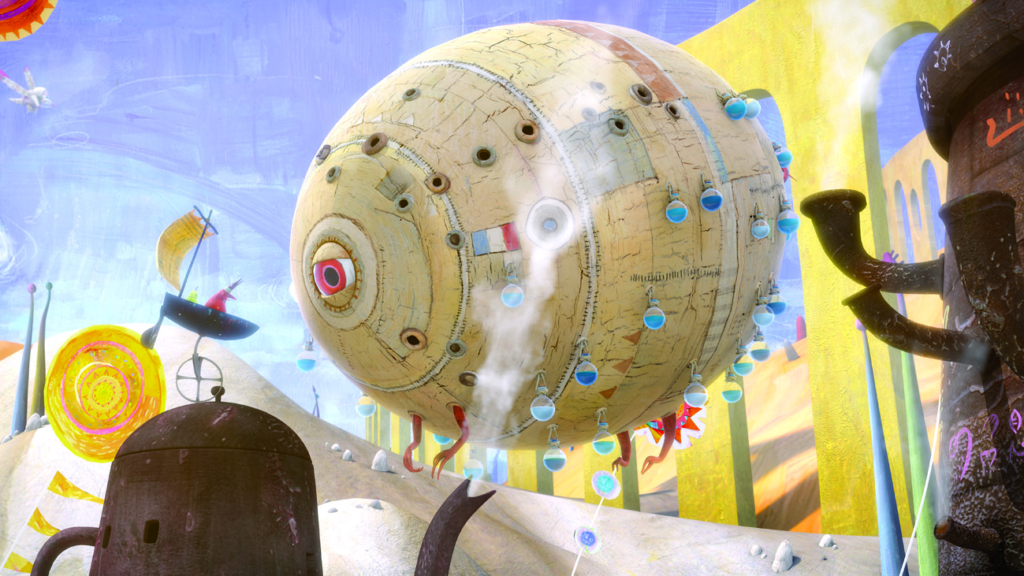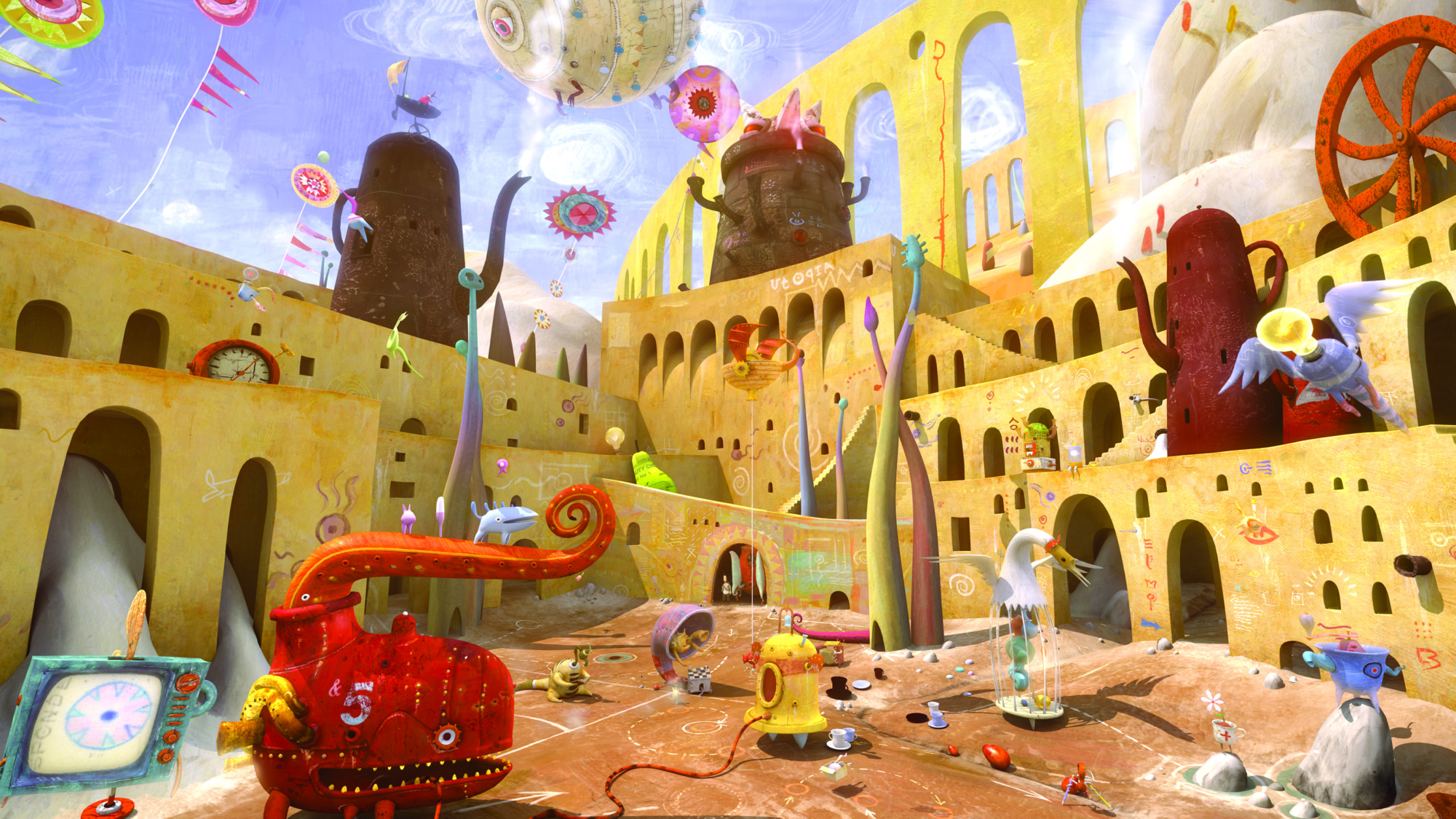Shaun Tan has emerged as one of Australia’s pre-eminent illustrators over the last ten years. His work uniquely fuses fantastical imagery with contemporary concerns: The Rabbits (written by John Marsden) is a dark metaphor for the colonisation of Australia, while The Red Tree examines depression with heartbreaking subtlety. But perhaps it is The Arrival, an examination of the migrant experience told solely in pictures, that has made Tan a widely known figure. Tan also worked as a concept artist during the development of Pixar’s Wall-E (Andrew Stanton, 2008) and for Horton Hears a Who (Jimmy Hayward and Steve Martino, 2008). He makes his directorial debut with The Lost Thing (2010), which he co-directed with Andrew Ruhemann.
Rjurik Davidson: How have you found the transition from illustrated books to film?
Shaun Tan: It’s quite a big question, because it has spanned a long period of time. It felt quite simple in some ways and complicated in others. I was already familiar with visual narrative and framing and things like that. I was less familiar with moving images and the language of cinematic editing. In illustrated books, what you’re trying to do is represent compressed scenes, which imply a lot of information about action. In film you do the same, but you are incorporating literal action. I guess it took me a while to get the hang of that. I’m used to organising images but not used to thinking about a time component or a dramatic arc that happens in between scenes or across the whole film. That was all quite tricky for me. Working on the film was like doing a long film-study course.

Why did you choose The Lost Thing?
The film more or less chose me. It wasn’t my initial idea to adapt it as a film – this was put to me by Passion Pictures in the UK, by the person who became my co-director, Andrew Ruhemann. He had been scouting for a short film project and came across the book at the Bologna book fair in Italy, where it won an honourable mention, an internationally recognised award. He responded very strongly to the story on a personal level, so that was the real appeal – as was the case for my producer, Sophie Byrne, whom I subsequently worked with very closely in developing the project. She actually chased me down a bit initially. I was at first lukewarm about the prospect of a film adaptation and worried that it might compromise the original story or something like that.
That said, of all the books I’ve produced, [The Lost Thing] would be the one that I would single out for adaptation as animation. I had actually mentioned this to one company in the past, which had been interested in a book I did earlier, The Rabbits – a project that never eventuated. At the time I thought The Lost Thing was crying out for a film treatment because the book was nicely concise but there were many details concerning the strange universe of the story that I felt deserved elaboration. I just didn’t have the space for it within a 32-page book.
‘When it came time to directing action, I knew fairly clearly how everything moved, right down to the weirdest little creatures – I’d been thinking about it for some years.’
– Shaun Tan
I also had very clear ideas about movement, more so than in most books I’ve illustrated. The Lost Thing has many more ‘action shots’: you’ve got the creature running, ringing his bells, looking around inquisitively. That’s very tricky to represent in the medium of painting. When it came time to directing action, I knew fairly clearly how everything moved, right down to the weirdest little creatures – I’d been thinking about it for some years.
That said, no ideas were exclusive. I’m used to collaborating with others, integrating multiple concerns, solving problems and trying to make the project interesting for co-creators. Because it’s not set in a real world, an idea is just an idea, you can’t say it’s right or wrong: it just has to ring true and be consistent. The visuals in the film are essentially a collaboration between four individuals, each with aesthetic ideas that became increasingly aligned over a long production period.

The world of The Lost Thing has themes of alienation and loneliness. You’ve said that you were able to explore some of the details of this world more. What were some of those things?
For instance, there are often background figures in white coats that are walking around, checking things. They’re maintenance people. They have a standardised uniform. I’m not sure if it’s obvious in the film because you don’t want to overstate details like that. They’re not important to the core narrative but they’re an interesting idea. It’s essentially a two-class society: people who work in offices and people who maintain machinery. Again, not a vital idea, but it does give an intuitive sense of a culture with limited imaginative opportunities. A lot of the things that the maintenance people are doing are essentially useless, such as putting fake seagulls on the beach, to make it look like a beach, and then removing them at the end of the day.
Or popping the little ball and sucking it into their vacuum …
Yeah, things like that. And they’re doing it in a very mechanical way – not aggressively, not with any kind of annoyance, just an apathetic everybody’s-doing-their-job attitude. The sound of the world is something that I had always had ideas about too. It works as an illustrated book because it’s a fairly quiet world. As you say, it has themes of alienation and loneliness, and the big faceless landscapes-of-concrete architecture suggests a fairly silent space. Within that is the character of the Lost Thing. In spite of its massive bulk and formidable appearance, it would have these dainty little bells, and it would communicate only like that, and have other strange sounds emanating from its body, a mix of heavy industrial and organic sounds. John Kassab, the sound designer, incorporated all those ideas into the design of the film, and the idea that any ambient sounds are all mechanical. It’s a post-ecological world, so there are no trees or other animals. I think we see a dog, and that’s about it. So you don’t hear birds chirping, it’s just the sound of machinery.

You’ve said that one of your early ideas was that The Lost Thing was a kind of response to economic rationalism, or that that sort of sparked the book, even though, as you’ve said elsewhere, the story and the book also refuse any one meaning, they’re very open-ended. Linked to this is The Arrival as a migrant story, which is a very on-the-front-page contemporary issue. Do you consider them critiques of contemporary society?
I guess they are, but they’re not active critiques. I don’t have an agenda. I don’t expect that the work is going to change the world. It’s not intended as political commentary. I think a lot of people make that mistake about my work. I actually have very little desire to make clear political comments; it’s more like an aesthetic criticism. Like you say, the book was inspired by these ideas of economic rationalism, and I guess that was bothering me a bit at the time. I felt there was something wrong with that philosophy. I was trying to figure out what it was, because it can be a good philosophy in some areas – otherwise nobody would advocate it – but when you apply it to the whole culture and the way people live as people, it can be quite dysfunctional.
In the end, the book becomes more like a comment on the presence or absence of aesthetic considerations in our society – and the virtue of imagination and play, and how those are often confined to childhood or the arts in our culture. In many ways our society is quite unusual when you look at it in broad historical context – I’m talking about geological time and how our ancestors lived – it’s now very much tied to abstract systems and bureaucratic infrastructures that give clarity and meaning, and do it well. But at the same time it risks the closure of other possibilities. So the story is about a meaningless thing in a very meaningful environment. By meaningful I mean mapped out: a place where everybody’s very literate, they understand the world and how it works. Characters like the Lost Thing meets with complete indifference, because it can’t be ‘read’ – it lacks definition.

The same was true with The Arrival. When that came out, a lot of people thought that it was a response to very current events, which couldn’t be further from the truth – in part because the book took five years to produce and I’d been thinking about it for ten. Also, I was interested in immigration from an aesthetic point of view, not the politics of immigration so much. I was thinking of personal stories and what a dramatic thing it would be to have to leave your home country, knowing that you can’t go back, and to travel to some place you’ve never been. I just thought that was a fascinating idea. In the course of doing that, I ended up telling an immigrant story. If it’s politically relevant at all – the same with The Lost Thing – it’s only because people have forgotten certain aspects of the debate. There’s a lack of discussion about the personal experience of people, a lack of empathy. The media and government paint images in very broad, abstract strokes, using language to reduce complex situations to ‘illegal immigrants’. It doesn’t really explain who they are or what’s really going on. The Lost Thing is about that problem also: the fact that we’re obsessed with words and convenient meanings and categorisations – the creature represents some resistance to that.
It’s really fascinating – that idea that the creature is uncategorisable, even in its physicality. It’s a crablike thing, but when its lid comes off there are these cogs that are whirring. It shows a bit of the influence of science fiction in your work. Do you consider yourself a science fiction or fantasy person?
Yeah, I do. I’m a number of things – like most creators, it would be odd to identify just one thing. In terms of literature and storytelling, I always go back to science fiction as an early influence. When I was about twelve, I started reading science fiction in a focused way, and thinking of it as something that extended beyond TV and movies, which tend to be quite conventional and decades behind the written word in terms of original content. The philosophical aspects of science fiction literature interested me the most – and continue to do so. I still have connections with the science fiction community in Australia and the US and was first published as a science fiction illustrator doing black-and-white drawings for small-press science fiction magazines.
‘I sit somewhere in between the world of fine art and science fiction, and believe they have many similarities between them, once you get past the elitism of the art world.’
– Shaun Tan
I sit somewhere in between the world of fine art and science fiction, and believe they have many similarities between them, once you get past the elitism of the art world. When you do a painting, even if it’s of a landscape, it’s always speculative, a kind of abstraction. You’re creating another universe on the canvas and science fiction stories do the same. You’re basically representing the world, but exaggerating or diminishing certain aspects as you go, distorting what you see and asking ‘what if?’ questions – drawing attention to certain things. The Lost Thing is not an accurate representation of the world at all. It’s a caricature, drawing attention to things that we know – elements of bureaucracy, for instance – and exaggerating them so that they are overstated in a way that’s both comical and depressing.

The scene at the Federal Department of Odds and Ends was reminiscent of Terry Gilliam’s Brazil (1985).
Brazil itself draws from 1984 by George Orwell. In Brazil it’s Information Retrieval, which is a version of the Ministry of Love in 1984. But yeah, that very much is a reference point for the Federal Department of Odds and Ends, except they all have different functions. So The Ministry of Love is for torturing political prisoners, Information Retrieval is for maintaining stifling bureaucracy, and the Department of Odds and Ends is for creating the illusion that everything has an ordered place, that everything is organised – it’s the bottom drawer in the kitchen where you chuck bits that don’t belong anywhere else, the miscellany folder in the filing cabinet. It creates the illusion that all else is naturally ordered.
Do you consider film particularly influential on you?
For sure, and even with illustration work it’s very influential. I think about scenes in books as cinematic scenes. If you look at The Arrival, it uses cinematic techniques such as pans, push-ins, pull-outs, focal shifts and so on. Because it’s kind of the same, it’s words and pictures, I don’t see there’s a great difference between picture books, comics, films or theatre productions. The moment you start telling a story and put in one or more images back-to-back, it becomes the overall medium – stories using images.
Are there directors like Gilliam whom you draw inspiration from, or is it more of a grab bag where you take things from all over the place?
It is a grab bag with some things being more ‘grab-able’ for me than others. So Gilliam is up there with someone like Ridley Scott, because his images look like paintings. Films by Pixar draw attention to lighting as a storytelling element. I find I’m really disappointed in films that don’t pay attention to those details and that actually forget that film is about telling a story primarily with pictures. Elements such as dialogue are important, but at the end of the day it’s moving pictures telling a story. I’m annoyed by films that could work better as radio plays or novels. Each frame should look like a painting, something you’d like to hang on the wall.
‘I’m annoyed by films that could work better as radio plays or novels. Each frame should look like a painting, something you’d like to hang on the wall.’
– Shaun Tan
I was interested that in The Lost Thing you and your co-director chose to tell the story with a narrator but you could have taken it in more directions had you wanted to, such as introducing more dialogue. Were there other decisions that you faced when you were putting the film together?
Endless ones. We did play with the idea that there would be no narrative at all. I was quite open to that idea, but unfortunately it doesn’t really work, because when you have concepts such as ‘something’s lost’, it’s very difficult to describe those visually, so you need that narrative. That said, the narrative was very stripped back at one point, and that worked fine, but at the same time with film you need that constant momentum, which you don’t need so much with an illustrated book – you just might move from point to point according to your own interest.
So we played around with multiple versions. I storyboarded the film at one point for a half-hour length and that involved changing the plot significantly. I also tried other lengths such as seventeen minutes, twenty-two minutes – often dictated by commercial concerns. Each time you do that you have to change all the content, given it’s an organic whole. In the end you will notice that the final film was very much like the book, but that wasn’t a straight adaptation – I wish! It ran a very convoluted course.

Are there things that you dislike about your own work?
I don’t think anyone is fully satisfied with their work, and if they are, then it’s probably not that good. I think my own work lacks spontaneity. It can be a bit too fussy. I try to constrain my use of details because there’s something about illustration that leads you to get carried away with details. That can be a lot of pleasure for the creator, but it’s not much fun to look at a complicated mass. A lot of the paintings I admire by other artists are fairly simple and spontaneous, and almost accidental. I’m always trying to approach this condition in my own work, but it’s a constant balance between clarity of detail and the vagueness of a spontaneous gesture, such as wiping a stroke of paint across the paper. Sometimes I think I err on the side of clarity. The concepts are too clear. I try to solve that by restraint in narrative, so if I have a very detailed picture such as the Lost Thing bouncing around and doing stuff, I dissolve the clarity of that by making it strange, by making it unrecognisable, so it’s still a very clear form but its meaning is blurry.
Usually when I write I overwrite everything, so editing for me is crucial. I’m not one of these people who can spool out a whole bunch of fantastic ideas. If anyone puts me on the spot and says, ‘Come up with a great story,’ they’re going to be really disappointed. A lot of my work happens in the editorial stage where I spill out a whole lot of stream–of-consciousness nonsense and then go back and pick out the 5 per cent of it that actually works. Then I just polish it and try different versions of it and a final product emerges. Sometimes I think it would be nice to do that spontaneous outpouring of ideas and leave it at that, but so many of the ideas are bad and embarrassing that I can’t bring myself to do that. I admire those artists who really are quite brave and just put all their stuff out there, but for me everything is about editing.

Will you keep working in film?
I’m not doing any film projects at the moment. There is some discussion relating to The Arrival, as there has always been some film interest in that book from different quarters. It’s just a matter of finding something that is desirable, achievable and realistic – we’ll see. In any case, I think I’ll always be working to some extent in film. At the same time I feel that the core of my work is painting and I can’t imagine that really changing. Every time that I pick up the brush or just go out sketching, I have a great feeling of rightness and creative satisfaction. I get that from film as well, but it’s a far more complicated process. There’s something about the simplicity of painting and the directness of putting your ideas down in the hermetically sealed environment of a studio, where it’s just you and a surface that you’re making marks on. It’s how I started making art and will probably be how I end.





